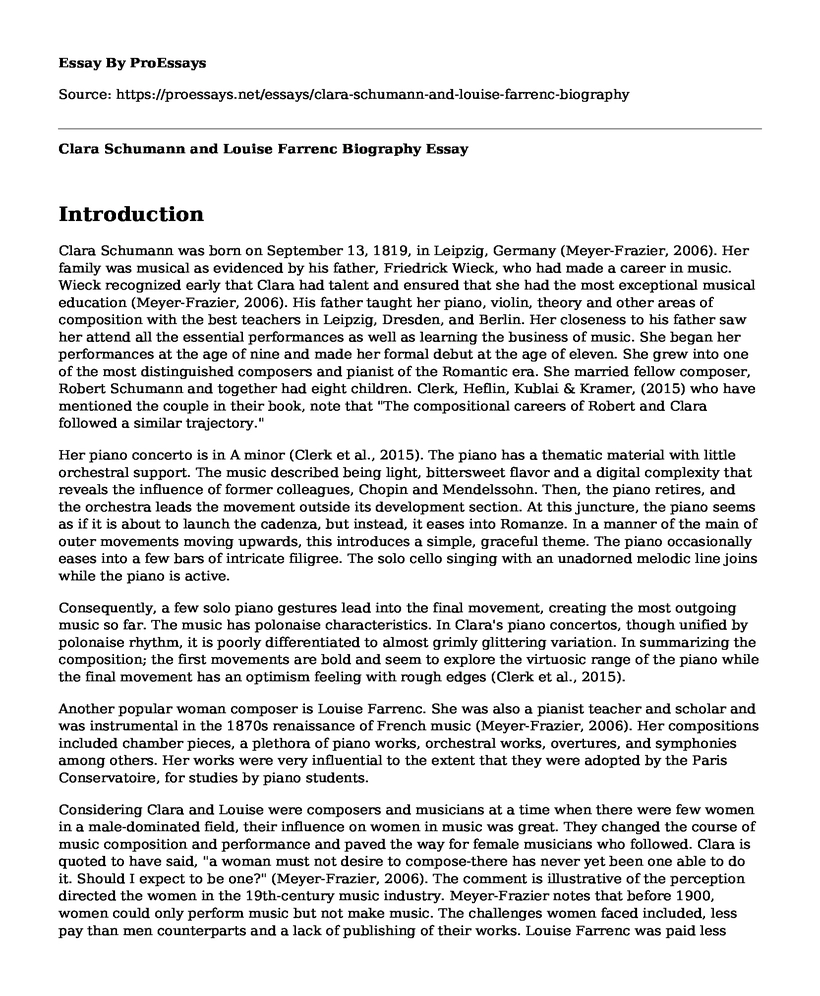Introduction
Clara Schumann was born on September 13, 1819, in Leipzig, Germany (Meyer-Frazier, 2006). Her family was musical as evidenced by his father, Friedrick Wieck, who had made a career in music. Wieck recognized early that Clara had talent and ensured that she had the most exceptional musical education (Meyer-Frazier, 2006). His father taught her piano, violin, theory and other areas of composition with the best teachers in Leipzig, Dresden, and Berlin. Her closeness to his father saw her attend all the essential performances as well as learning the business of music. She began her performances at the age of nine and made her formal debut at the age of eleven. She grew into one of the most distinguished composers and pianist of the Romantic era. She married fellow composer, Robert Schumann and together had eight children. Clerk, Heflin, Kublai & Kramer, (2015) who have mentioned the couple in their book, note that "The compositional careers of Robert and Clara followed a similar trajectory."
Her piano concerto is in A minor (Clerk et al., 2015). The piano has a thematic material with little orchestral support. The music described being light, bittersweet flavor and a digital complexity that reveals the influence of former colleagues, Chopin and Mendelssohn. Then, the piano retires, and the orchestra leads the movement outside its development section. At this juncture, the piano seems as if it is about to launch the cadenza, but instead, it eases into Romanze. In a manner of the main of outer movements moving upwards, this introduces a simple, graceful theme. The piano occasionally eases into a few bars of intricate filigree. The solo cello singing with an unadorned melodic line joins while the piano is active.
Consequently, a few solo piano gestures lead into the final movement, creating the most outgoing music so far. The music has polonaise characteristics. In Clara's piano concertos, though unified by polonaise rhythm, it is poorly differentiated to almost grimly glittering variation. In summarizing the composition; the first movements are bold and seem to explore the virtuosic range of the piano while the final movement has an optimism feeling with rough edges (Clerk et al., 2015).
Another popular woman composer is Louise Farrenc. She was also a pianist teacher and scholar and was instrumental in the 1870s renaissance of French music (Meyer-Frazier, 2006). Her compositions included chamber pieces, a plethora of piano works, orchestral works, overtures, and symphonies among others. Her works were very influential to the extent that they were adopted by the Paris Conservatoire, for studies by piano students.
Considering Clara and Louise were composers and musicians at a time when there were few women in a male-dominated field, their influence on women in music was great. They changed the course of music composition and performance and paved the way for female musicians who followed. Clara is quoted to have said, "a woman must not desire to compose-there has never yet been one able to do it. Should I expect to be one?" (Meyer-Frazier, 2006). The comment is illustrative of the perception directed the women in the 19th-century music industry. Meyer-Frazier notes that before 1900, women could only perform music but not make music. The challenges women faced included, less pay than men counterparts and a lack of publishing of their works. Louise Farrenc was paid less than her male counterpart for nearly a decade, and it was only after the triumphant premiere of her Nonet for winds and strings did she demand and receive equal pay. The women were influential in that they took up the teaching of composition and various other music genres.
References
Clerk, A., Heflin, T., Kluball, J., & Kramer, E. (2015). Understanding Music: Past and Present. Dahlonega, Georgia: University of North Georgia Press.
Meyer-Frazier, P. (2006). Music, Novels, and Women: Nineteenth-Century Prescriptions for an Ideal Life. Women And Music: A Journal Of Gender And Culture, 10(1), 45-59. doi: 10.1353/wam.2007.0010
Cite this page
Clara Schumann and Louise Farrenc Biography. (2022, Nov 21). Retrieved from https://proessays.net/essays/clara-schumann-and-louise-farrenc-biography
If you are the original author of this essay and no longer wish to have it published on the ProEssays website, please click below to request its removal:
- Film Analysis Essay on Ethnic Notions
- Racism: Documentary Analysis Essay
- Traditional Music of the Asante People in Ghana Essay
- Music Analysis Essay on Ebony Concerto by Igor Stravinsky
- Social Distortion and Fake News - Essay Sample
- Essay Example on 5 Steps of Writing Development: Prewriting, Drafting, Revising, Editing and Publishing
- Essay on MTV: Music, Controversy, and a Legacy of Youth Networking.







